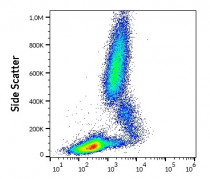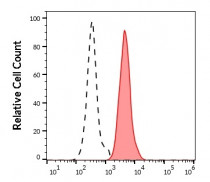ARG62720
anti-CD11c antibody [BU15] (FITC)
anti-CD11c antibody [BU15] (FITC) for Flow cytometry and Human,Monkey
Developmental Biology antibody; Immune System antibody; Signaling Transduction antibody
Overview
| Product Description | FITC-conjugated Mouse Monoclonal antibody [BU15] recognizes CD11c |
|---|---|
| Tested Reactivity | Hu, Mk |
| Tested Application | FACS |
| Specificity | The clone BU15 reacts with CD11c (alphaX, p150), a 150 kDa integrin expressed mainly on dendritic cells and tissue macrophages. HLDA III; WS Code M 256 HLDA V; WS Code AS S143 HLDA VI; WS Code AS Ref.6 |
| Host | Mouse |
| Clonality | Monoclonal |
| Clone | BU15 |
| Isotype | IgG1 |
| Target Name | CD11c |
| Immunogen | Dendritic cells of synovial fluid |
| Conjugation | FITC |
| Alternate Names | CD antigen CD11c; Leu M5; CD11C; SLEB6; Integrin alpha-X; Leukocyte adhesion glycoprotein p150,95 alpha chain; Leukocyte adhesion receptor p150,95; CD11 antigen-like family member C |
Application Instructions
| Application Suggestion |
|
||||
|---|---|---|---|---|---|
| Application Note | * The dilutions indicate recommended starting dilutions and the optimal dilutions or concentrations should be determined by the scientist. |
Properties
| Form | Liquid |
|---|---|
| Purification Note | The purified antibody is conjugated with Fluorescein isothiocyanate (FITC) under optimum conditions. The reagent is free of unconjugated FITC and adjusted for direct use. No reconstitution is necessary. |
| Buffer | PBS, 15 mM Sodium azide and 0.2% (w/v) high-grade protease free BSA |
| Preservative | 15 mM Sodium azide |
| Stabilizer | 0.2% (w/v) high-grade protease free BSA |
| Storage Instruction | Aliquot and store in the dark at 2-8°C. Keep protected from prolonged exposure to light. Avoid repeated freeze/thaw cycles. Suggest spin the vial prior to opening. The antibody solution should be gently mixed before use. |
| Note | For laboratory research only, not for drug, diagnostic or other use. |
Bioinformation
| Database Links | |
|---|---|
| Gene Symbol | ITGAX |
| Gene Full Name | integrin, alpha X (complement component 3 receptor 4 subunit) |
| Background | CD11c (p150, alphaX integrin subunit) forms complex with CD18 (beta2 integrin subunit) and is expressed mainly on tissue macrophages and dendritic cells. CD11c binds to complement fragment iC3b, fibrinogen, VCAM-1 and ICAM-2 or e.g. CD90. Like other beta2 integrins, CD11c/CD18 plays roles in cell migration and phagocytosis. Moreover, interaction of CD11c/CD18 with plasminogen regulates plasmin activities, and interaction with heparin counteracts binding of iC3b. |
| Function | Integrin alpha-X/beta-2 is a receptor for fibrinogen. It recognizes the sequence G-P-R in fibrinogen. It mediates cell-cell interaction during inflammatory responses. It is especially important in monocyte adhesion and chemotaxis. [UniProt] |
| Research Area | Developmental Biology antibody; Immune System antibody; Signaling Transduction antibody |
| Calculated MW | 128 kDa |
Images (2) Click the Picture to Zoom In
-
ARG62720 anti-CD11c antibody [BU15] (FITC) FACS image
Flow Cytometry: Human peripheral whole blood stained with ARG62720 anti-CD11c antibody [BU15] (FITC) (20 µl reagent / 100 µl of peripheral whole blood).
-
ARG62720 anti-CD11c antibody [BU15] (FITC) FACS image
Flow Cytometry: Separation of human monocytes (red-filled) from CD11c negative lymphocytes (black-dashed). Human peripheral whole blood stained with ARG62720 anti-CD11c antibody [BU15] (FITC) (20 µl reagent / 100 µl of peripheral whole blood).
Clone References









